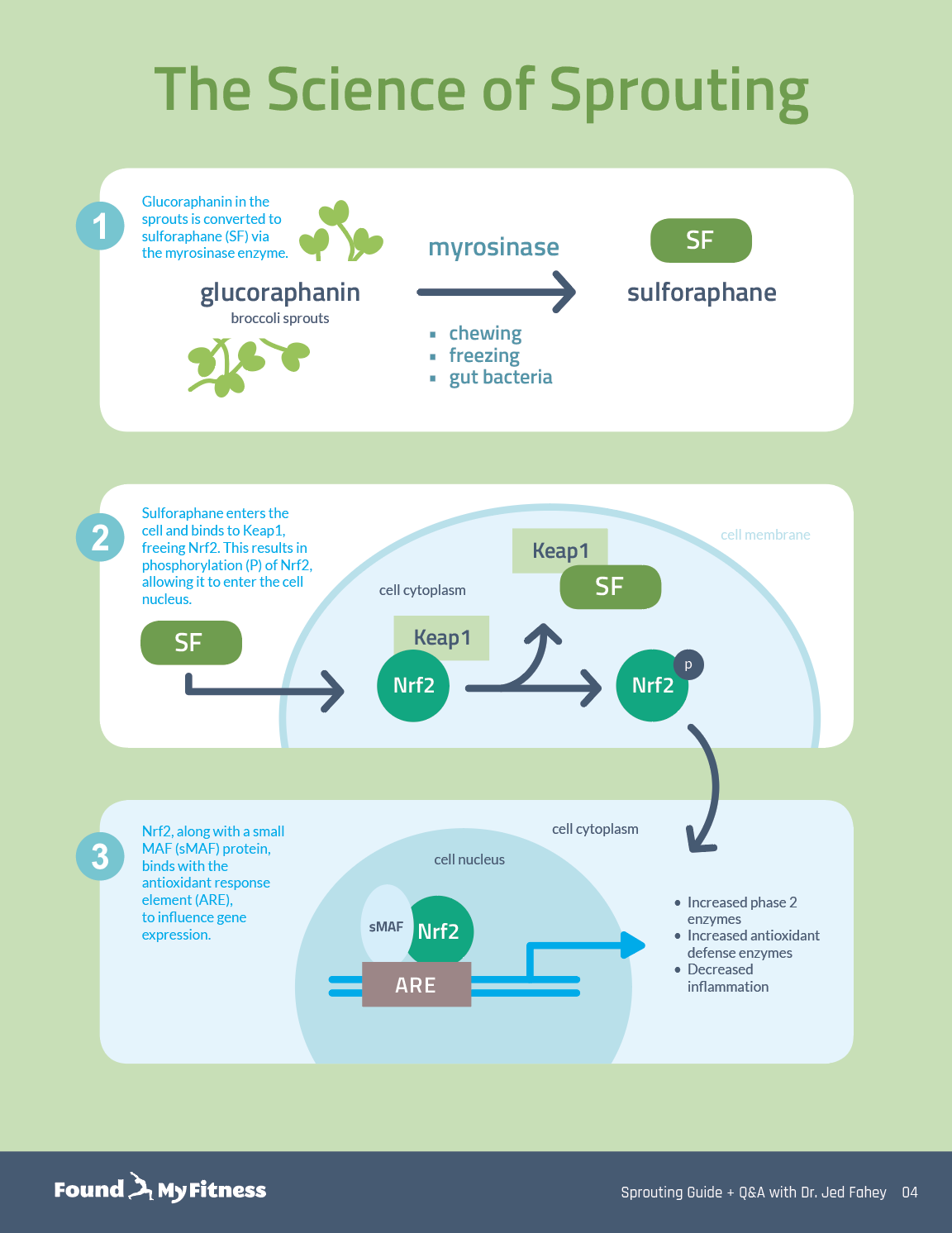Sulforaphane increases glutathione in the brain | Jed Fahey
Enter your email to get our 15-page guide to sprouting broccoli and learn about the science of chemoprotective compount sulforaphane.
Broccoli sprouts are concentrated sources of sulforaphane, a type of isothiocyanate. Damaging broccoli sprouts – when chewing, chopping, or freezing – triggers an enzymatic reaction in the tiny plants that produces sulforaphane.

Get the full length version of this episode as a podcast.
This episode will make a great companion for a long drive.
A growing body of evidence suggests that sulforaphane's protective effects extend to the brain. Glutathione, a potent endogenous antioxidant compound, is a likely mediator of these effects. Data from preclinical models of glutathione deficiency, supported by magnetic resonance spectroscopy studies, show increased glutathione levels in the brains of people who receive sulforaphane. In this clip, Dr. Jed Fahey discusses how sulforaphane promotes glutathione production in the brain, even with long-term consumption.
- [Dr. Patrick]: "On the Kevin Rode podcast Rhonda Patrick mentioned that broccoli sprouts increase the production of glutathione in the brain. So I was wondering what your thoughts are on continuous supplementation. If taken long-term, would the brain stop producing it naturally?"
So for people, for reference, that aren't familiar, the clinical study that I referred to on Kevin's podcast the "Kevin Rose Show" was in 2018, published in 2018, and they found that about 17.7 milligrams sulforaphane per day for one week increased blood glutathione levels, and this correlated with increased glutathione in certain brain regions. And these were in healthy people. So, you know, as Jed mentioned, glutathione is one of the body's major antioxidant systems.
So I guess you kind of answered that already, but maybe you want to...if there's any concluding thoughts you want to give.
[Dr. Fahey]: Yeah, yeah. So I kind of did answer that just now. And actually I think I was a co-author of that study of that study you're referring to, if it's the one by Tom Sedlak and Akira Sawa and others.
[Dr. Patrick]: You were, that's right.
[Dr. Fahey]: Yeah.
[Dr. Patrick]: Shame on me.
[Dr. Fahey]: No, no, no. That's okay. They did the heavy work on the study, I didn't. But, so indeed with healthy people they showed what you said. And so I think there's...the brain won't stop producing glutathione naturally, there's no question about that. And glutathione production...
[Dr. Patrick]: What about during age, the aging process?
[Dr. Fahey]: It declines naturally with age. And, in fact, starting as early as in your 20s. So, Rhonda, you're in the downhill slope already.
[Dr. Patrick]: For sure.
[Dr. Fahey]: I'm way down. So, you know, supplementing with sulforaphane, I think, apparently helps to restore glutathione back to normal, or young healthy levels. And I think some animal studies by that same group have shown that.
[Dr. Patrick]: In the brain, I mean how freaking cool is that? I mean I've seen studies... I was just...it was a small clinical study, you know, but I was just blown away that you guys showed that it increased levels in the brain.
[Dr. Fahey]: I think it is pretty freaking cool. And I think also the study that you're referring to, or a related study by Sedlak and Sawa and others in radiology at Hopkins, showed that...they also showed in people they were able to show...to localize that enhanced glutathione by a functional MRI. Or... Yeah, by...
[Dr. Patrick]: Yeah.
[Dr. Fahey]: So, I mean, the imaging, just to sort of...it's not icing on the cake, it's the future. And, I mean, I think we're going to see, I hope we're going to see, a lot more functional MRI type studies where people say, "Yeah, yeah, yeah. I see this and that in the blood, I see this and that in the urine. You know, I see conversion. I see these," whether it's drugs or phytochemicals, "I see these effects in blood." But we don't really care that much about blood except as an index or a market. What we care about is is it doing something in the brain or the muscles or, you know, whatever.
And so these...now with higher resolution MRI, people are able to show these changes and it's pretty cool. If I had...if I was reborn and rebranded as a scientist, I'd want to be a microbiome specialist. But I'm way past that. But I think I'd always want to be a functional MRI person because that's going to be very cool as we go forward.
A molecule that inhibits oxidative damage to DNA, proteins, and lipids in cells. Oxidative damage plays a role in the aging process, cancer, and neurodegeneration. Many vitamins and plant-based compounds are antioxidants.
An antioxidant compound produced by the body’s cells. Glutathione helps prevent damage from oxidative stress caused by the production of reactive oxygen species.
An essential mineral present in many foods. Iron participates in many physiological functions and is a critical component of hemoglobin. Iron deficiency can cause anemia, fatigue, shortness of breath, and heart arrhythmias.
The collection of genomes of the microorganisms in a given niche. The human microbiome plays key roles in development, immunity, and nutrition. Microbiome dysfunction is associated with the pathology of several conditions, including obesity, depression, and autoimmune disorders such as type 1 diabetes, rheumatoid arthritis, muscular dystrophy, multiple sclerosis, and fibromyalgia.
A chemical that causes Parkinson's disease-like symptoms. MPTP undergoes enzymatic modification in the brain to form MPP+, a neurotoxic compound that interrupts the electron transport system of dopaminergic neurons. MPTP is chemically related to rotenone and paraquat, pesticides that can produce parkinsonian features in animals.
Highly reactive molecules that have the ability to oxidize other molecules and cause them to lose electrons. Common oxidants are oxygen, hydrogen peroxide, and superoxide anion.
pK is a measure of proton binding affinity. If a compound or molecule has low pK (less than 2.5), it has low affinity for binding protons. Strong acids have low pK. If a compound or molecule has high pK (greater than 3.0), it has high affinity for binding protons. Weak acids have high pK.
An isothiocyanate compound derived from cruciferous vegetables such as broccoli, cauliflower, and mustard. Sulforaphane is produced when the plant is damaged when attacked by insects or eaten by humans. It activates cytoprotective mechanisms within cells in a hormetic-type response. Sulforaphane has demonstrated beneficial effects against several chronic health conditions, including autism, cancer, cardiovascular disease, diabetes, and others.
Supporting our work
If you enjoy the fruits of
 , you can participate in helping us to keep improving it. Creating a premium subscription does just that! Plus, we throw in occasional member perks and, more importantly, churn out the best possible content without concerning ourselves with the wishes of any dark overlords.
, you can participate in helping us to keep improving it. Creating a premium subscription does just that! Plus, we throw in occasional member perks and, more importantly, churn out the best possible content without concerning ourselves with the wishes of any dark overlords.
Sulforaphane News
- Broccoli seed extract with a sulforaphane precursor reduced common cold symptom days in healthy adults.
- Sulforaphane-rich broccoli sprout extract modestly lowers fasting blood sugar in some people with prediabetes, perhaps due to variations in gut microbiota and individual metabolic traits.
- Sulforaphane, derived from broccoli, activates Nrf2, mitigating age-related skin changes and boosting the antioxidant defense system in mice.
- Sulforaphane from broccoli sprouts shows promise in preventing Alzheimer's disease – boosting memory and enhancing mitochondrial function in mice.
- Breathwork enhances endogenous antioxidant enzyme activity to counter oxidative stress.






